The electrically actuated micro robots market is set to grow significantly from USD 10,683.0 million in 2025 to USD 43,595.9 million by 2035, reflecting a CAGR of 15.1%. In the initial phase, from 2021 to 2025, the market experiences steady growth, moving from USD 5,288.3 million to USD 10,683.0 million. This is driven by the increasing adoption of micro robots in industries like healthcare, industrial automation, and laboratories, where their precision and small size offer operational advantages. As these robots prove effective for tasks such as minimally invasive surgery, diagnostics, and micro-manufacturing, demand continues to rise. The market’s steady pace during these early years is due to growing awareness of the benefits of micro robots, particularly in sectors with space and operational constraints.
The global electrically actuated micro robots market is projected to grow from USD 10,683.0 million in 2025 to approximately USD 43,595.9 million by 2035, recording an absolute increase of USD 32,912.9 million over the forecast period. This translates into a total growth of 308.1%, with the market forecast to expand at a compound annual growth rate (CAGR) of 15.1% between 2025 and 2035. The overall market size is expected to grow by nearly 4.1X during the same period, supported by increasing adoption of minimally invasive medical procedures, growing demand for precision manufacturing applications, and rising integration of artificial intelligence technologies in micro-robotics systems requiring advanced actuation and control capabilities.
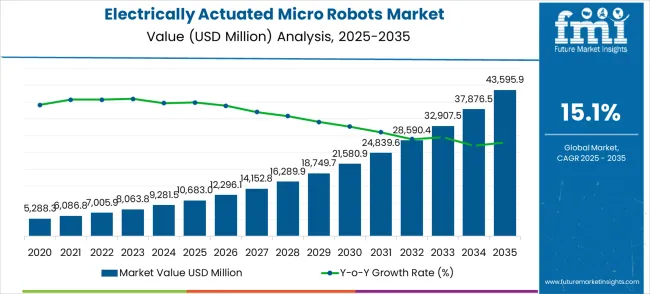
From 2026 to 2035, the market accelerates as technological advancements such as AI integration, miniaturization, and energy-efficient systems further expand applications in healthcare, aerospace, agriculture, and environmental monitoring. During this period, the market grows from USD 10,683.0 million to USD 43,595.9 million, with new entrants pushing the boundaries of micro-robotics technology. While large players consolidate their position through mergers and acquisitions, smaller players gain market share by targeting niche sectors with specialized solutions. The market experiences both growth and erosion in terms of market share, driven by constant technological innovation and the growing demand for high-performance robots in precision-driven industries.
Between 2025 and 2030, the electrically actuated micro robots market is projected to expand from USD 10,683.0 million to USD 21,649.8 million, resulting in a value increase of USD 10,966.8 million, which represents 33.3% of the total forecast growth for the decade. This phase of growth will be shaped by accelerating medical robotics adoption, increasing precision manufacturing requirements, and growing integration of micro-robotics in automotive and electronics applications. Robotics manufacturers are expanding their electrically actuated micro robot portfolios to address the growing demand for miniaturized automation solutions with enhanced precision and intelligent control characteristics.
| Metric | Value |
|---|---|
| Estimated Value in (2025E) | USD 10,683.0 million |
| Forecast Value in (2035F) | USD 43,595.9 million |
| Forecast CAGR (2025 to 2035) | 15.1% |
The electrically actuated micro robots market holds a specific share within its parent markets. Within the robotics market, it contributes around 3-5% due to its specialized applications in both industrial and medical robotics. In the healthcare robotics market, the share is about 4-6%, driven by demand for minimally invasive surgeries and robotic-assisted therapies. Within the industrial automation market, the share is approximately 2-4%, as micro robots are used in high-precision tasks requiring miniaturized automation. In the nanotechnology market, micro robots hold about 1-3%, focused on advanced nano-scale applications. In the advanced manufacturing market, the share is roughly 3-5%, as the adoption of miniaturized robotics enhances production processes in precision industries.
From 2030 to 2035, the market is forecast to grow from USD 21,649.8 million to USD 43,595.9 million, adding another USD 21,946.1 million, which constitutes 66.7% of the overall ten-year expansion. This period is expected to be characterized by widespread deployment of autonomous micro-robotic systems, integration with advanced AI and machine learning technologies, and development of next-generation medical and industrial applications. The growing demand for personalized medicine and Industry 4.0 automation will drive adoption of sophisticated electrically actuated micro robots with enhanced intelligence and autonomous operation capabilities.
Between 2020 and 2025, the electrically actuated micro robots market experienced rapid technological advancement, driven by breakthrough developments in miniaturization technologies and growing recognition of micro-robotics potential across medical and industrial applications. The market evolved as researchers and manufacturers achieved significant progress in electric actuation systems, sensor integration, and control algorithms for micro-scale robotic systems. Substantial investment in research and development established the foundation for commercial deployment across various specialized applications requiring precise manipulation at microscopic scales.
Market expansion is being supported by the revolutionary potential of micro-robotics in enabling previously impossible applications across medical, manufacturing, and research sectors. Modern healthcare providers and industrial manufacturers are increasingly focused on precision solutions that can operate at microscopic scales while maintaining high accuracy and reliability. The proven capability of electrically actuated micro robots to deliver targeted drug delivery, perform minimally invasive procedures, and enable precision assembly makes them essential components of next-generation medical and manufacturing systems.
The growing emphasis on personalized medicine and precision manufacturing is driving demand for micro-robotic technologies that can support individualized treatment approaches and high-precision production processes. Industry preference for automation solutions that can operate in confined spaces, perform complex manipulations, and integrate with existing systems is creating opportunities for advanced micro-robotics development. The rising influence of artificial intelligence and autonomous systems is also contributing to increased demand for intelligent micro-robots across different application sectors and operational scenarios.
The market is segmented by classification, application, and region. By classification, the market is divided into wheeled type, crawler type, and others. Based on application, the market is categorized into pharmaceutical industry, healthcare industry, automotive industry, manufacturing industry, military, and others. Regionally, the market is divided into Asia Pacific, North America, Europe, Latin America, and Middle East & Africa.
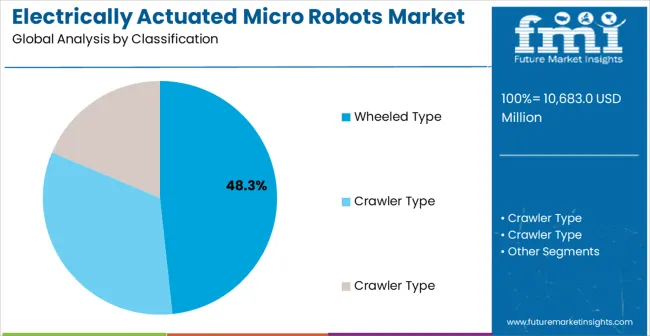
The wheeled type classification is projected to account for 48.3% of the electrically actuated micro robots market in 2025, reaffirming its position as the category's dominant design approach. Robotics engineers increasingly recognize the superior mobility and control characteristics provided by wheeled micro-robot designs for applications requiring rapid movement and precise positioning. This classification addresses the most versatile operational requirements while providing essential maneuverability and speed characteristics.
This classification forms the foundation of most micro-robotics applications, as it represents the most practical and widely adaptable approach for micro-scale mobility systems. Technology development and miniaturization progress continue to strengthen confidence in wheeled micro-robot performance. With increasing recognition of the importance of efficient locomotion and precise control, wheeled designs align with both current application requirements and future development roadmaps. Their broad compatibility across multiple applications ensures sustained market dominance, making them the central growth driver of electrically actuated micro robot adoption.
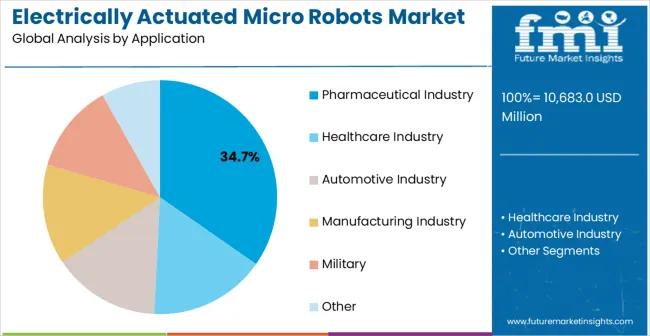
Pharmaceutical industry applications are projected to represent 34.7% of electrically actuated micro robots demand in 2025, underscoring their role as the primary application driving market development. Pharmaceutical companies recognize that drug delivery and therapeutic applications require the most sophisticated and precisely controlled micro-robotic systems to ensure safety and efficacy. Pharmaceutical applications demand exceptional precision and biocompatibility that electrically actuated micro robots are uniquely positioned to deliver.
The segment is supported by the continuous advancement of targeted therapy approaches requiring sophisticated delivery mechanisms and the growing deployment of personalized medicine applications across healthcare systems. Additionally, Ppharmaceutical research is increasingly adopting micro-robotic technologies that can enable new treatment modalities while improving patient outcomes. As understanding of therapeutic micro-robotics advances, pharmaceutical applications will continue to serve as the primary commercial driver, reinforcing their essential position within the micro-robotics market.
The electrically actuated micro robots market is advancing rapidly due to breakthrough developments in miniaturization technologies and growing demand for precision medical and industrial applications. However, theThe market faces challenges including complex manufacturing requirements, regulatory approval processes for medical applications, and technical hurdles in achieving reliable micro-scale operation. Innovation in micro-fabrication techniques and control systems continue to influence product development and market expansion patterns.
The growing integration of artificial intelligence is enabling more sophisticated micro-robot applications with enhanced autonomous operation and decision-making capabilities. Advanced AI platforms offer comprehensive control algorithms, including machine learning and adaptive behavior, that are particularly important for complex micro-robotics applications. Autonomous systems provide access to intelligent operation that can optimize task performance and adapt to changing conditions.
Modern robotics companies are incorporating advanced micro-fabrication techniques, miniaturized sensor arrays, and wireless communication systems to enhance electrically actuated micro robot performance and functionality. These technologies improve positioning accuracy, enable real-time monitoring, and provide enhanced operational feedback throughout mission execution. Advanced integration also enables optimized power management and improved system reliability characteristics.
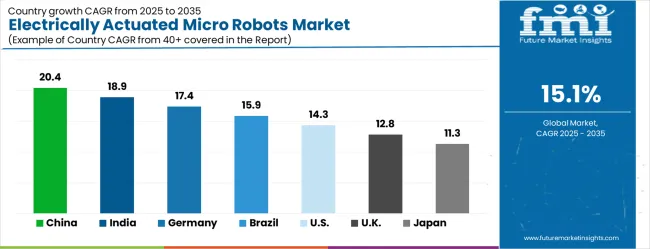
| Country | CAGR (2025-2035) |
|---|---|
| China | 20.4% |
| India | 18.9% |
| Germany | 17.4% |
| Brazil | 15.9% |
| USA | 14.3% |
| UK | 12.8% |
| Japan | 11.3% |
The electrically actuated micro robots market is experiencing exceptional growth globally, with China leading at a 20.4% CAGR through 2035, driven by massive investment in robotics research and development, government support for advanced manufacturing technologies, and rapidly expanding healthcare and industrial automation sectors. India follows at 18.9%, supported by growing pharmaceutical manufacturing capabilities, increasing investment in medical technology, and expanding precision manufacturing applications. Germany shows growth at 17.4%, emphasizing precision engineering excellence and comprehensive industrial automation. Brazil records 15.9% growth, focusing on expanding healthcare technology adoption and growing investment in medical robotics. The USA shows 14.3% growth, representing strong innovation leadership in medical robotics and advanced manufacturing technologies.
The report covers an in-depth analysis of 40+ countries; seven top-performing countries are highlighted below.
The electrically actuated micro robots market in China is expected to experience significant growth with a CAGR of 20.4% through 2035. Revenue from electrically actuated micro robots in China is projected to exhibit extraordinary growth with a CAGR of 20.4% through 2035, driven by unprecedented investment in robotics research and development and comprehensive government support for advanced manufacturing and medical technology development. The country's leading position in robotics innovation and increasing capabilities in micro-manufacturing technologies are creating tremendous opportunities for micro-robotics adoption. Major domestic and international robotics companies are establishing comprehensive research and production facilities to serve the rapidly expanding micro-robotics market.
The market for electrically actuated micro robots in India is forecast to expand at a CAGR of 18.9%. Revenue from electrically actuated micro robots in India is expanding at a CAGR of 18.9%, supported by the rapidly growing pharmaceutical manufacturing sector, increasing investment in medical technology, and expanding precision manufacturing capabilities. The country's substantial healthcare market and commitment to technology advancement are driving demand for advanced micro-robotic solutions. International robotics companies and domestic manufacturers are establishing partnerships to serve the growing demand for precision medical and manufacturing technologies.
The electrically actuated micro robots market in Germany is set to grow at a rate of 17.4%. Revenue from electrically actuated micro robots in Germany is projected to grow at a CAGR of 17.4%, supported by the country's leadership in precision engineering and comprehensive expertise in advanced manufacturing technologies. German robotics and medical device companies consistently invest in cutting-edge micro-robotics technologies and precision automation systems. The market is characterized by advanced engineering capabilities, comprehensive industry collaboration, and established relationships between technology developers and end users.
Brazil is projected to experience steady growth in the electrically actuated micro robots market, with a CAGR of 15.9%. Revenue from electrically actuated micro robots in Brazil is projected to grow at a CAGR of 15.9% through 2035, driven by expanding healthcare technology adoption, increasing investment in medical device development, and growing focus on advanced manufacturing capabilities. Brazilian healthcare providers and manufacturers are increasingly adopting sophisticated micro-robotic technologies to support medical innovation and manufacturing precision.
The market for electrically actuated micro robots in the United States is expected to rise at a CAGR of 14.3%. Revenue from electrically actuated micro robots in the USA is projected to grow at a CAGR of 14.3%, supported by established leadership in medical robotics, substantial investment in research and development, and comprehensive healthcare technology infrastructure. American robotics companies and healthcare providers consistently advance micro-robotics technologies through established innovation programs and clinical research collaboration.
The UK market for electrically actuated micro robots is expected to grow at a CAGR of 12.8%. Revenue from electrically actuated micro robots in the UK is projected to grow at a CAGR of 12.8% through 2035, supported by medical technology innovation initiatives and increasing investment in precision healthcare solutions. British healthcare providers and research institutions emphasize the development of advanced micro-robotic systems within comprehensive medical frameworks that prioritize patient outcomes and clinical effectiveness.
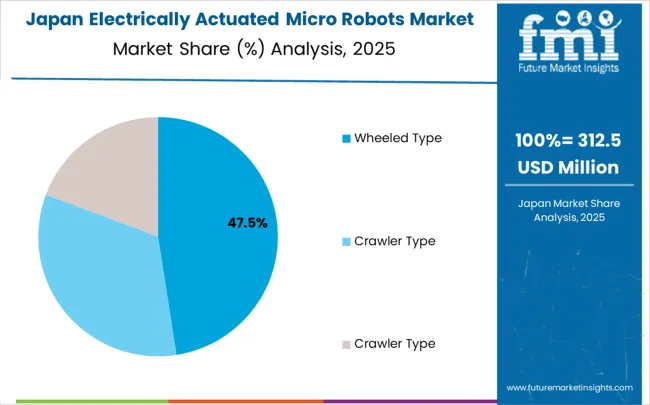
In Japan, the market for electrically actuated micro robots is projected to expand at a CAGR of 11.3% Revenue from electrically actuated micro robots in Japan is projected to grow at a CAGR of 11.3% through 2035, supported by the country's leadership in precision robotics and comprehensive approach to advanced manufacturing technologies. Japanese robotics companies and manufacturers emphasize innovation-driven development of sophisticated micro-robotic systems within established frameworks that prioritize technical excellence and manufacturing precision.
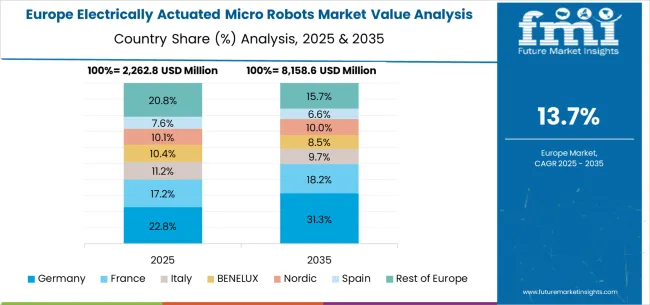
The electrically actuated micro robots market in Europe is projected to expand rapidly through 2035, supported by increasing investment in medical technology, rising adoption of precision manufacturing, and ongoing innovation in micro-robotics applications. Germany will continue to lead the regional market, accounting for 30.2% in 2025 and rising to 31.6% by 2035, supported by strong precision engineering capabilities, advanced manufacturing infrastructure, and comprehensive research and development programs. The United Kingdom follows with 19.7% in 2025, increasing to 20.1% by 2035, driven by medical technology innovation initiatives, government support for robotics development, and expanding research collaboration networks.
France holds 17.1% in 2025, edging up to 17.4% by 2035 as manufacturers expand micro-robotics capabilities and demand grows for precision medical and industrial applications. Italy contributes 12.8% in 2025, remaining stable at 13.0% by 2035, supported by manufacturing innovation and growing adoption of advanced robotics technologies. Spain is projected to represent 9.4% in 2025, rising to 9.6% by 2035, driven by the expansion of healthcare technology adoption and increasing investment in precision manufacturing.
Nordic countries together account for 6.7% in 2025, maintaining their position at 6.8% by 2035, supported by advanced technology initiatives and early adoption of innovative micro-robotics solutions. The Rest of Europe represents 4.1% in 2025, declining slightly to 1.5% by 2035, as larger markets capture greater investment focus and technology development resources.
The electrically actuated micro robots market is characterized by competition among specialized medical robotics companies, established automation manufacturers, and innovative micro-technology firms. Companies are investing in advanced miniaturization technologies, artificial intelligence integration, strategic partnerships, and clinical research to deliver high-performance, reliable, and clinically effective micro-robotic solutions. Technology development, regulatory compliance, and market positioning strategies are central to strengthening competitive advantages and market presence.
Microbot Medical leads the market with significant expertise in medical micro-robotics development, offering innovative electrically actuated solutions with focus on therapeutic applications and clinical effectiveness. Cyborg Nest offers advanced human-machine interface technologies, with a focus on biomedical applications. EndoControl focuses on medical robotics, offering comprehensive capabilities for endoscopic and minimally invasive procedures. Capsule Technologies delivers healthcare technology solutions with a strong focus on patient monitoring and medical device integration.
Medtronic operates with a focus on comprehensive medical device manufacturing and an established healthcare market presence. Epson Robotics leverages precision manufacturing expertise to develop miniaturized robotic systems. KUKA AG offers industrial automation capabilities with a focus on precision robotics applications. Seiko Epson Corporation specializes in precision manufacturing and micro-mechanical systems. Precision Microdrives and FANUC Corporation provide diverse technological approaches and manufacturing expertise to enhance overall market development and technology advancement across multiple application sectors.
| Items | Values |
|---|---|
| Quantitative Units (2025) | USD 10,683.0 mMillion |
| Classification | Wheeled Type, Crawler Type, Others |
| Application | Pharmaceutical Industry, Healthcare Industry, Automotive Industry, Manufacturing Industry, Military, Other |
| Regions Covered | Asia Pacific, North America, Europe, Latin America, Middle East & Africa |
| Countries Covered | China, India, Germany, Brazil, United States, United Kingdom, Japan and 40+ countries |
| Key Companies Profiled | Microbot Medical, Cyborg Nest, EndoControl, Capsule Technologies, Medtronic, Epson Robotics, KUKA AG, Seiko Epson Corporation, Precision Microdrives, FANUC Corporation |
| Additional Attributes | Dollar sales by robot type and application, regional technology adoption trends, competitive landscape, clinical research partnerships, integration with AI and control systems, innovations in micro-fabrication and actuation technologies, regulatory compliance analysis, and therapeutic outcome optimization strategies |
The global electrically actuated micro robots market is estimated to be valued at USD 10,683.0 million in 2025.
The market size for the electrically actuated micro robots market is projected to reach USD 43,595.9 million by 2035.
The electrically actuated micro robots market is expected to grow at a 15.1% CAGR between 2025 and 2035.
The key product types in electrically actuated micro robots market are wheeled type, crawler type and crawler type.
In terms of application, pharmaceutical industry segment to command 34.7% share in the electrically actuated micro robots market in 2025.






Our Research Products

The "Full Research Suite" delivers actionable market intel, deep dives on markets or technologies, so clients act faster, cut risk, and unlock growth.

The Leaderboard benchmarks and ranks top vendors, classifying them as Established Leaders, Leading Challengers, or Disruptors & Challengers.

Locates where complements amplify value and substitutes erode it, forecasting net impact by horizon

We deliver granular, decision-grade intel: market sizing, 5-year forecasts, pricing, adoption, usage, revenue, and operational KPIs—plus competitor tracking, regulation, and value chains—across 60 countries broadly.

Spot the shifts before they hit your P&L. We track inflection points, adoption curves, pricing moves, and ecosystem plays to show where demand is heading, why it is changing, and what to do next across high-growth markets and disruptive tech

Real-time reads of user behavior. We track shifting priorities, perceptions of today’s and next-gen services, and provider experience, then pace how fast tech moves from trial to adoption, blending buyer, consumer, and channel inputs with social signals (#WhySwitch, #UX).

Partner with our analyst team to build a custom report designed around your business priorities. From analysing market trends to assessing competitors or crafting bespoke datasets, we tailor insights to your needs.
Supplier Intelligence
Discovery & Profiling
Capacity & Footprint
Performance & Risk
Compliance & Governance
Commercial Readiness
Who Supplies Whom
Scorecards & Shortlists
Playbooks & Docs
Category Intelligence
Definition & Scope
Demand & Use Cases
Cost Drivers
Market Structure
Supply Chain Map
Trade & Policy
Operating Norms
Deliverables
Buyer Intelligence
Account Basics
Spend & Scope
Procurement Model
Vendor Requirements
Terms & Policies
Entry Strategy
Pain Points & Triggers
Outputs
Pricing Analysis
Benchmarks
Trends
Should-Cost
Indexation
Landed Cost
Commercial Terms
Deliverables
Brand Analysis
Positioning & Value Prop
Share & Presence
Customer Evidence
Go-to-Market
Digital & Reputation
Compliance & Trust
KPIs & Gaps
Outputs
Full Research Suite comprises of:
Market outlook & trends analysis
Interviews & case studies
Strategic recommendations
Vendor profiles & capabilities analysis
5-year forecasts
8 regions and 60+ country-level data splits
Market segment data splits
12 months of continuous data updates
DELIVERED AS:
PDF EXCEL ONLINE
Electrically Conductive Adhesives Market Size and Share Forecast Outlook 2025 to 2035
Electrically-Driven Heavy-Duty Aerial Work Platforms Market Size and Share Forecast Outlook 2025 to 2035
Electrically Conductive Coating Market Size and Share Forecast Outlook 2025 to 2035
SLAM Robots Market Size and Share Forecast Outlook 2025 to 2035
Delta Robots Market
Mobile Robots Market Size and Share Forecast Outlook 2025 to 2035
Pharma Robots Market Size and Share Forecast Outlook 2025 to 2035
Nuclear Robots Market Size and Share Forecast Outlook 2025 to 2035
Kitting Robots Market Size and Share Forecast Outlook 2025 to 2035
Milking Robots Market Size and Share Forecast Outlook 2025 to 2035
Airport Robots Market Size and Share Forecast Outlook 2025 to 2035
Painting Robots Market Size and Share Forecast Outlook 2025 to 2035
Security Robots Market Size and Share Forecast Outlook 2025 to 2035
Military Robots Market Size and Share Forecast Outlook 2025 to 2035
Surgical Robots Market
Pipetting Robots Market Size and Share Forecast Outlook 2025 to 2035
Logistics Robots Market Size and Share Forecast Outlook 2025 to 2035
Inspection Robots Market Size and Share Forecast Outlook 2025 to 2035
Dispensing Robots Market Size and Share Forecast Outlook 2025 to 2035
Palletizing Robots Market Size and Share Forecast Outlook 2025 to 2035

Thank you!
You will receive an email from our Business Development Manager. Please be sure to check your SPAM/JUNK folder too.
Chat With
MaRIA